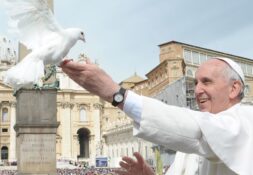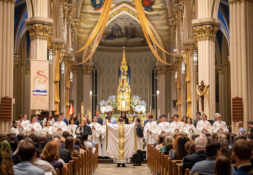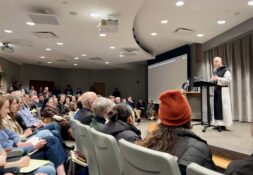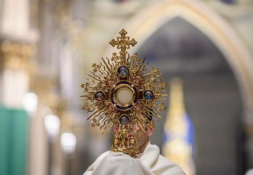Traditional “Bitter Sorrows” celebrated at Notre Dame
The Bitter Sorrows (Gorzkie żale) is a traditional Polish Lenten devotion, sung during adoration of the Most Blessed Sacrament. It was prayed for the first time at Notre Dame in the Log Chapel on the first Sunday of Lent this year. Fr. Brendan McAleer, C.S.C. presided over the devotional service, which was organized jointly by the Militia of the Immaculata and the Knights of Columbus.
The devotion is a musical meditation on the Passion of Christ and the sorrows of His Mother. The name “Bitter Sorrows” is derived from the opening lines of the invitatory, the first hymn of the devotion: “Come, O come ye bitter sorrows.” In Poland, this devotion is sung on the Sundays of Lent in the afternoon.
Junior Jakub Wielgus, a Polish-American from the suburbs of Chicago who helped organize the service, commented: “To a Polish-speaking Catholic like myself, the Bitter Sorrows are one of the things that make Lent special. So the fact that more people are learning about and praying with them through a translation is beautiful. To me, it felt like bringing a piece of home back with me to Notre Dame.”
The Bitter Sorrows were published anonymously in 1707 in Warsaw under the title “A Bundle of Myrrh from the Garden of Gethsemane, or the Sorrowfully Bitter Passion of the Son of God, […] a Meditation.” They have been attributed to the Vincentian priest Fr. Wawrzyniec Stanisław Benik, C.M.
According to the records of the Confraternity of St. Roch, its members tried to observe Lent by meditating upon the Passion of Christ with the Fasciculus myrrhæ (“A Bundle of Myrrh”), a Latin devotion based on the mystery plays of the Middle Ages. The complex structure of the Fasciculus myrrhæ and the fact that it was in Latin made it hard for members of the confraternity to meditate with it.
At the same time as the Confraternity of St. Roch struggled with the Fasciculus myrrhæ, they would organize processions of penitents on the streets of Warsaw in Lent. They would, however, purposefully organize these processions at the same time as a rival confraternity at a church next door, causing the two confraternities to argue over which procession had precedence. These arguments caused such a public disturbance that the pastor of Holy Cross Church, Fr. Michał Bartłomiej Tarło, C.M., forbade the Confraternity of St. Roch from organizing Lenten penitential processions at all in 1707.
Because of this ban on organizing Lenten processions and struggles with praying with the Fasciculus myrrhæ, the Confraternity of St. Roch decided to create a meditation on the Passion in Polish with a structure based on the office of Matins, now called the Office of Readings.
The Bitter Sorrows begin with an invitatory, followed by three “parts,” each composed of three hymns. Each part meditates upon a different element of the Passion. The first hymn of each part is sung by all and is simply called the “Hymn”; the second hymn is a litany called the “Soul’s Lament over the Suffering Christ”; and the third hymn is called the “Soul’s Conversation with the Sorrowful Mother.”
The verses of this last hymn—the words of the Sorrowful Mother—are sung by the women congregants, while the words of the soul are sung by the men, keeping an element of the mystery plays from which this devotion descends.
After they were published, the Bitter Sorrows spread quickly across Poland and Lithuania, with even the King of Poland and Grand Duke of Lithuania, August III, praying the devotion. The devotion was brought to the United States by Polish immigrants in the 1850s and to this day is sung in Polish churches across the country.
Great Polish saints such as St. John Paul II and St. Faustyna Kowalska meditated with this devotion. St. Faustyna received a vision of Christ during one such meditation.
Sophomore Paul Gates, an undergraduate seminarian who served for the Bitter Sorrows on February 18, reflected on his experience: “Our culture is currently trying to expel grief from our lives, even though it is natural that we grieve, cry, and struggle in response to loss. We cannot skip grief, just as we must first hail the Cross before we can experience the hope that comes from it. The Bitter Sorrows did a tremendous job of materializing my grief for the Lord, giving me the appropriate words to express to Jesus in the Most Holy Sacrament of the Altar how sorry I am; how grieved I am by His death; and how much I love Him.”
The Bitter Sorrows will be sung twice more this Lent, on March 3 and 24 at 3:30 p.m. in the Log Chapel.
Bartosz is a local Bitter Sorrows expert and would gladly procrastinate by answering questions about them via email. Contact him at bartosz.chramiec@nd.edu.
Photo Credit: Teresa Chramiec
Subscribe to the Irish Rover here.
Donate to the Irish Rover here.





